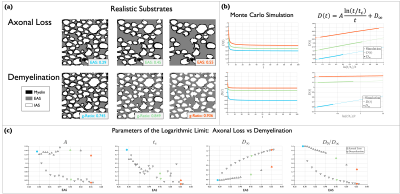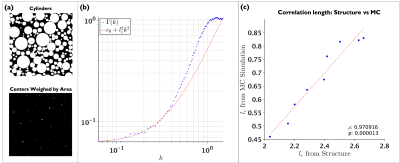Ricardo Coronado-Leija1, Hong-Hsi Lee1, Els Fieremans1, and Dmitry S. Novikov1
1Radiology, New York University School of Medicine, New York, NY, United States
1Radiology, New York University School of Medicine, New York, NY, United States
Using Monte Carlo simulations, we show that time-dependent diffusion in the extra-axonal space can provide information that differentiates between axon loss and demyelination. D(t) can also provide information related to the density-correlation-function, such as the correlation-length

Figure 3. (a) Examples of realistic substrates generated to simulate axon loss and demyelination. Colors label different EAS fractions. (b) D(t) was obtained from MC simulations and Equation (1) was fitted. (c) $$$D_{\infty}$$$, and $$$D_0/D_{\infty}$$$ show similar behavior than for the substrates with cylinders, $$$t_c$$$ is more noisy and shows similar behavior for both conditions, $$$A$$$ differentiates between axon loss and demyelination, but shows a flat-like behavior for larger EAS. The effect of axon shape in $$$D(t)$$$ needs to be further investigated.

Figure 1. (a) A substrate containing only the centers, weighted by the area of the cylinders is created to compute the power-spectrum (Fourier transform of the density-correlation-function) $$$\Gamma(k)$$$, free of shape effects. (b) For small $$$k$$$, $$$\Gamma(k)\sim c_0+l_c^2k^2$$$. (c) Pearson correlation coefficient, between $$$l_c$$$ computed from $$$\Gamma(k)$$$ and $$$l_c$$$ computed from MC, indicate high and significant correlation. This indicates that structural information can be obtained from $$$D(t)$$$.